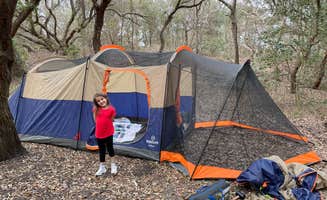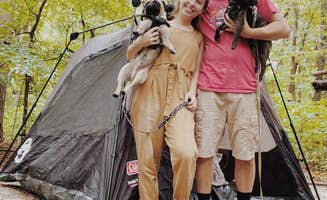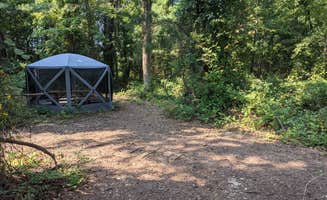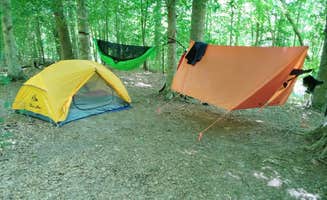Tent campsites near Virginia Beach, Virginia require advance preparation, especially during peak summer season when temperatures average 85-90°F with high humidity. Most primitive camping areas have limited cell service, with the strongest signals found at Sandy Bottom Nature Park due to its proximity to urban areas. Camping platforms range from sandy coastal areas to more compact woodland clearings, each offering distinct wildlife viewing opportunities.
What to do
Kayaking and paddling: At Sandy Bottom Nature Park, rental boats provide an accessible way to explore the 456-acre property. "There are kayaks and paddle boats you can rent by the hour. This park has plenty of camping spots and also has some yurts that are available to rent out," notes Brandon W.
Wildlife viewing: Bird watching opportunities abound throughout the coastal region, with multiple habitat types supporting diverse species. At Merchants Millpond Canoe-In Campground, campers can spot numerous aquatic species. "We saw a bald eagle's nest, snakes, frogs, turtles, and lily pads everywhere. One of my kids caught a gar," reports Becky E.
Beach exploration: Coastal camping allows for extended beach time without fighting traffic. "Nothing better than a beach sunset. Plus there are a ton of different types of birds out there if you like wildlife. My cousin even caught a few baby sharks," shares Sam M. about his experience at False Cape State Park.
What campers like
Private beach access: The remote location of False Cape State Park Campground creates a sense of having your own beach. "Really there wasn't hardly anyone else out there, so it felt like we had our own private beach. We hiked out to our spot, but we saw some people biking into theirs," reports Sam M.
Limited technology distractions: Most tent sites near Virginia Beach have minimal cell reception, creating opportunities to disconnect. "We came home exhausted, sunburnt, blisters, but just in awe of this amazing park. It's definitely worth the hike!" Katie M. shares about her False Cape experience.
Diverse ecosystems: The combination of coastal and inland habitats provides varied camping experiences. At Wisteria Beach Hideaway, campers appreciate the natural setting. "Loved the location - the beaches were surrounded by pine, wetlands, and tall grasses - it felt remote and not overdeveloped!" notes Kat H.
What you should know
Pack-in requirements: Most Virginia Beach tent sites require carrying all gear and supplies. "We're both in good shape, and on bike we made the trek in less than an hour. I rode my mountain bike, and my wife road her hybrid commuter bike without issue," explains Tim R. about reaching his False Cape campsite.
Water management: Limited drinking water access means planning ahead. "We brought a collapsible 5 gallon jug that I had to ride back to the visitors center (about 2 miles from our campsite) to fill up," Tim R. advises about camping at False Cape State Park.
Weather preparation: Coastal camping means wind and sun exposure. "It was super windy at the beach but at our campsite under the trees it felt great," reports Kailyn U. at False Cape State Park.
Tips for camping with families
Bike transport for children: Many Virginia Beach tent sites require significant hiking, but families have found solutions. "We took our 9 month old and 2 year old children. We towed them in a trailer and they loved their time at the beach," shares Tim R. about camping at False Cape State Park.
Shorter tent camping options: For families with small children, consider sites with less hiking required. "The sites were located about 1/4 mile from the parking lot down a trail. They were spaced nicely apart and had nice sand tent platforms with a picnic table and a fire ring with a grate," reports liz J. about Sandy Bottom Nature Park.
Kid-friendly activities: Look for campgrounds with established recreation options. "There are miles of trails around the lake and through the woods you can follow. It is extremely dog friendly with a fenced in dog park as well," explains Brandon W. about Sandy Bottom Nature Park.
Tips from RVers
Alternative boat-in options: For RVers seeking similar experiences without the hike, consider canoe-in sites. At Bennetts Creek Canoe In Campground, "It was a 4.5 mile paddle to the site, then roughly 1.5 down to the dock with a staged vehicle," reports todd B.
Vehicle considerations: Some locations have specific vehicle restrictions or challenging access. "If you don't plan on paddling with a kayak or maybe a canoe don't risk it. I was going to take a Jon boat with a trolling motor and there are countless limbs and the overgrowth is terrible you will not make it through," warns Edward H. about Merchants Millpond State Park.
Noise factors: Some campgrounds have unexpected noise sources. "The biggest negative was that no matter where you were in the park, there was significant noise from the highway. Horns honking, sirens blaring, the general rush of cars going by," notes liz J. about Sandy Bottom Nature Park.





